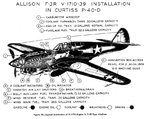kool kitty89
Senior Master Sergeant
I thought the oil coolers were in the wing leading edges and the prestone radiators were either under the nose or under the fuselage (with the chin being an intake duct)In the case of XP-40Q, two radiators were relocated in the wings, hence the smaller 'beard' that now housed only one (oil?) radiator.
You yourself mentioned the LE oil coolers here:
http://www.ww2aircraft.net/forum/aviation/xp-40q-able-35878-post983430.html#post983430
The initial P-40Q prototype appears to have had the oil coolers grouped with the coolant radiators all under the wing center section.
I'm not sure if either configuration caused the wing center fuel tankage to be reduced. (or eliminated the belly rack)
You also loose the centerline bomb/drop tank rack, though less of an issue if you use the annular radiator (or BMW radial) on fighter-bomber versions.The annular radiator circumvents the need to have the boundary layer splitter. In case we want a P-51-style radiator, one of the fuel tanks must go - not such a big problem, there is enough of space between the spars for fuel tanks, but still a work to be done.
One of my points was that the Jumo 211 should have had more room for growth (at least in high altitude performance) with a single stage supercharger before a 2-stage unit was worthwhile and that a 605AS featuring an intercooler would also be useful. (perhaps less useful on the 603A given the lower compression ratios used)The Jumo 213A and DB 603A/E were among the best 1-stage engines, once sorted out. Strong points being the ability to use 87 oct fuel and still perform, the shortcoming being greater weight and bulk, as well as lower power above 20000 ft than a decent 2-stage supercharged 700-750 kg (dry) engine, let alone with 2-stage 1000 kg engines.
It still looks a bit smaller, maybe not much smaller than the P-40C's scoop, but smaller than the P-40E/F/K/L/N's.I am not sure how much smaller the "nose" was on the P-40Q. It just may have hidden better behind a bigger prop hub
It does appear to be deeper too, extending to the belly section.

